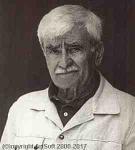Alberto Burri
Alberto Burri
Stijl: Art Informel;
Plaats: Città Di Castello
Geboren: 1915
Dood: 1995
Biografie:
Alberto Burri was an Italian painter and sculptor considered a key figure in Post-War art and such artistic movements as Neo-Dada, Nouveau réalisme, postminimalism and Arte Povera.
In one of his very rare statements, Burri claimed that the critics’ words, as well as his own, were of no use in offering a description of his artworks, affirming that its only real key strength was the formal balance that poor and industrial materials were surprisingly able to give.
Alberto Burri was born on 12 March 1915 in Città di Castello, Umbria to a Tuscan wine merchant (Pietro Burri) and an Umbrian elementary school teacher (Carolina Torregiani).
During his adolescence he preferred soccer to school, even though he soon felt an inclination towards Ancient Greek (anticipatory of his future readings) and Drawing, although not included in his school subjects.
Having been born in a region rich in art, he shared great bike rides and the contemplation of Renaissance art with the brothers Alvaro and Nemo Sarteanesi, both art students at that time and later on important figures in the artistic tutelage of Città di Castello.
After a Medical Degree at the University of Perugia and a precocious voluntary experience in the Italo-Ethiopian War, Burri was then recalled to military service on 12 October 1940, two days after Italy’s entrance into World War II, and sent to Libya as a combat medic.
On 8 May 1943 the unit he was part of was captured by the British in Tunisia and was later turned over to the Americans and transferred to Hereford, Texas in a prisoner-of-war camp housing around 3000 Italian officers.
Prevented from practicing his medical profession, Burri had the opportunity of choosing a leisure activity thanks to the YMCA Association. Using the limited amount of materials available in the camp he took on the activity of painting, at the age of almost 30 and without any kind of academic reference.
Meanwhile, the tragic death of his younger brother Vittorio on the Russian front in 1943 had a strong impact on him.
Shutting himself off from the rest of the world, and depicting figurative subjects on thick chromatic marks, he progressively realized the desire of abandoning the medical profession, in favor of painting.
Once Burri returned to Italy on 27 February 1946, his decision collided with the severe post–World War II recession and his parents’ dissatisfaction. He moved to Rome as a guest of the violinist and composer Annibale Bucchi, his mother’s cousin, who encouraged his activity as a painter.
While in Rome, he had the chance of establishing a contact with the few but very active institutions dedicated to painting, which were creating a new platform for visual arts after the war.
He remained a reserved artist, ceaselessly working and creating, initially in a small studio in Via Margutta but frequently moving out. As a matter of fact, Milton Gendel – an American journalist who visited Burri’s studio in 1954 –, later reported: "The studio is thick-walled, whitewashed, neat and ascetic; his work is ‘blood and flesh,’ reddened torn fabric that seems to parallel the staunching of wounds that Burri experienced in wartime.”
Burri’s first solo figurative artworks exhibition took place on 10 July 1947 at the gallery-cum-bookshop La Margherita, in Rome, presented by the poets Leonardo Sinisgalli and Libero De Libero. However, Burri’s artistic production flowed definitively into abstract forms before the end of the same year, the use of small format tempera resulting from the influence of such artists as Jean Dubuffet and Joan Miró, whose studio was visited by Burri during a trip to Paris in the winter of 1948.
Burri’s artistic research became highly personal in very short time: between 1948 and 1950 he began experimenting with using unusual, ‘unorthodox’ materials such as tar, sand, zinc, pumice, and Aluminium dust as well as Polyvinyl chloride glue, this last material being elevated to the same importance as oil colors. During this artistic transition, the painter showed his sensitivity to the mixed-media type of abstraction of Enrico Prampolini, a central figure in Italian Abstract art. Nonetheless Burri went one step further in his Catrami (Tars), presenting tar not as a simple collage material, but as an actual color which – by way of different lucid and opaque shades in monochrome black–, blended itself with the totality of the painting.
His 1948 “Nero 1” (Black 1) was later taken by the artist as initial milestone of his painting and established the prevalence of the black monochrome, which will be maintained as close identity throughout his career, alongside white, since Bianchi (Whites) 1949-50 series, and red.
The following series of Muffe (Molds) literally presented the spontaneous reactions of the materials employed, enabling matter to ‘come to life’ in drippings and concretions which reproduced the effects and appearance of real mold. In some artworks of the same period which he called Gobbi (Hunchbacks), Burri focused on the painting’s spatial interaction, achieving another original outcome due to the incorporation of tree branches on the rear of the canvas which pushed two-dimensionality towards Three-dimensional space.
More...
Wikipedia link: Click Here










